Papers by Hajime Watanabe

Journal of Molecular Endocrinology, 2006
Recent studies have revealed that hundreds of genes in the uterus are activated by estrogen. Thei... more Recent studies have revealed that hundreds of genes in the uterus are activated by estrogen. Their expression profiles differ over time and doses and it is not clear whether all these genes are directly regulated by estrogen via the estrogen receptor. To select the genes that may be regulated by estrogen, we treated mice with several doses of estrogen and searched for those genes whose dose–response expression pattern mirrored the uterine growth pattern. Among those genes, we found that the dose-dependent expression of the adrenomedullin (ADM) gene correlated well with the uterotrophic effect of estrogen. ADM expression is induced early after estrogen administration and is restricted to the endometrial stroma. The spatiotemporal gene expression pattern of ADM was similar to that of receptor-modifying protein 3 (RAMP3). RAMP3 is known to modify calcitonin gene-related receptor (CRLR) so that it can then serve as an ADM receptor. Chromatin immunoprecipitation assays indicated that the...
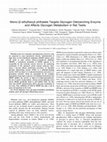
Toxicological Sciences, 2009
Phthalate esters are commonly used plasticizers; however, some are suspected to cause reproductiv... more Phthalate esters are commonly used plasticizers; however, some are suspected to cause reproductive toxicity. Administration of high doses of di-(2-ethylhexyl) phthalate (DEHP) induces germ cell death in male rodents. Mono-(2-ethylhexyl) phthalate (MEHP), a hydrolyzed metabolite of DEHP, appears to be responsible for this testicular toxicity; however, the underlying mechanism of this chemical's action remains unknown. Here, using a one-step affinity purification procedure, we identified glycogen debranching enzyme (GDE) as a phthalate-binding protein. GDE has oligo-1,4-1,4-glucanotransferase and amylo-1,6glucosidase activities, which are responsible for the complete degradation of glycogen to glucose. Our findings demonstrate that MEHP inhibits the activity of oligo-1,4-1,4-glucanotransferase, but not of amylo-1,6-glucosidase. Among various phthalate esters tested, MEHP specifically binds to and inhibits GDE. We also show that DEHP administration affects glycogen metabolism in rat testis. Thus, inhibition of GDE by MEHP may play a role in germ cell apoptosis in the testis.
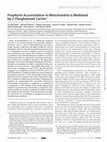
Journal of Biological Chemistry, 2006
Heme (Fe-protoporphyrin IX), an endogenous porphyrin derivative, is an essential molecule in livi... more Heme (Fe-protoporphyrin IX), an endogenous porphyrin derivative, is an essential molecule in living aerobic organisms and plays a role in a variety of physiological processes such as oxygen transport, respiration, and signal transduction. For the biosynthesis of heme or the mitochondrial heme proteins, heme or its biosynthetic precursor porphyrin must be transported into mitochondria from cytosol. The mechanism of porphyrin accumulation in the mitochondrial inner membrane is unclear. In the present study, we analyzed the mechanism of mitochondrial translocation of porphyrin derivatives. We showed that palladium meso-tetra(4-carboxyphenyl)porphyrin (PdTCPP), a phosphorescent porphyrin derivative, accumulated in the mitochondria of several cell lines. Using affinity latex beads, we showed that 2-oxoglutarate carrier (OGC), the mitochondrial transporter of 2-oxoglutarate, bound to PdTCPP, and in vitro PdTCPP inhibited 2-oxoglutarate uptake into mitochondria in a competitive manner (K i ؍ 15 M). Interestingly, all types of porphyrin derivatives examined in this study competitively inhibited 2-oxoglutarate uptake into mitochondria, including protoporphyrin IX, coproporphyrin III, and hemin. Furthermore, mitochondrial accumulation of porphyrins was inhibited by 2-oxoglutarate or OGC inhibitor. These results suggested that porphyrin accumulation in mitochondria is mediated by OGC and that porphyrins are able to competitively inhibit 2-oxoglutarate uptake into mitochondria. This is the first report of a putative mechanism for accumulation of porphyrins in the mitochondrial inner membrane.
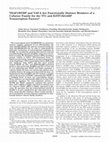
Journal of Biological Chemistry, 2002
The transcription factor hGABP/E4TF1 is a heterotetrameric complex composed of two DNA-binding su... more The transcription factor hGABP/E4TF1 is a heterotetrameric complex composed of two DNA-binding subunits (hGABP␣/E4TF1-60) and two transactivating subunits (hGABP/E4TF1-53). In order to understand the molecular mechanism of transcriptional regulation by hGABP, we searched for proteins that interact with the non-DNA-binding subunit, hGABP, using yeast two-hybrid screening. We identified a human cDNA encoding a protein related to YAF-2 (YY1-associated factor 2), which was previously isolated as an interacting partner of the Ying-Yang-1 (YY1) transcription factor. Reflecting this similarity, both YAF-2 and this novel protein (named YEAF1 for YY1-and E4TF1/hGABP-associated factor-1) interacted with hGABP and YY1 in vitro and in vivo, indicating that YEAF1 and YAF-2 constitute a cofactor family for these two structurally distinct transcription factors. By using yeast three-hybrid assay, we demonstrated that hGABP and YY1 formed a complex only in the presence of YEAF1, indicating that YEAF1 is a bridging factor of these two transcription factors. These cofactors are functionally different in that YAF-2 positively regulates the transcriptional activity of hGABP but YEAF1 negatively regulates this activity. Also, YAF-2 mRNA is highly expressed in skeletal muscle, whereas YEAF1 mRNA is highly expressed in placenta. We speculate that the transcriptional activity of hGABP is in part regulated by the expression levels of these tissue-specific cofactors. These results provide a novel mechanism of transcriptional regulation by functionally distinct cofactor family members.
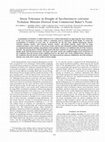
Applied and Environmental Microbiology, 1999
Accumulation of trehalose is widely believed to be a critical determinant in improving the stress... more Accumulation of trehalose is widely believed to be a critical determinant in improving the stress tolerance of the yeastSaccharomyces cerevisiae, which is commonly used in commercial bread dough. To retain the accumulation of trehalose in yeast cells, we constructed, for the first time, diploid homozygous neutral trehalase mutants (Δnth1), acid trehalase mutants (Δath1), and double mutants (Δnth1 ath1) by using commercial baker’s yeast strains as the parent strains and the gene disruption method. During fermentation in a liquid fermentation medium, degradation of intracellular trehalose was inhibited with all of the trehalase mutants. The gassing power of frozen doughs made with these mutants was greater than the gassing power of doughs made with the parent strains. The Δnth1 and Δath1strains also exhibited higher levels of tolerance of dry conditions than the parent strains exhibited; however, the Δnth1 ath1 strain exhibited lower tolerance of dry conditions than the parent strain ...
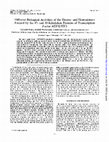
Journal of Virology, 1991
The transcription factor ATF/E4TF3 stimulates transcription from the adenovirus early region 4 (E... more The transcription factor ATF/E4TF3 stimulates transcription from the adenovirus early region 4 (E4) promoter by binding to specific promoter elements. Among the multiple forms of ATF/E4TF3, two forms with molecular masses of 47 and 43 kDa, which are most active in transcription in vitro from the E4 promoter, have been purified to homogeneity from HeLa cells by sequence-specific DNA affinity chromatography and biochemically characterized. Each purified protein formed a homodimer. These two homodimers were easily altered into a heterodimer when mixed together in the absence, but not in the presence, of the specific DNA sequence. All of these dimers were able to activate transcription in vitro from the E4 promoter by binding to the specific DNA sequence. Their activities to bind to DNA or stimulate transcription were different. The ability of the 47-kDa homodimer to stimulate transcription in vitro from the E4 promoter was approximately nine and three times higher than the abilities of...
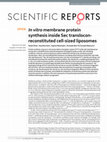
Scientific reports, Jan 3, 2016
Protein synthesis using an in vitro transcription-translation system (IVTT) inside cell-sized lip... more Protein synthesis using an in vitro transcription-translation system (IVTT) inside cell-sized liposomes has become a valuable tool to study the properties of biological systems under cell-mimicking conditions. However, previous liposome systems lacked the machinery for membrane protein translocation. Here, we reconstituted the translocon consisting of SecYEG from Escherichia coli inside cell-sized liposomes. The cell-sized liposomes also carry the reconstituted IVTT, thereby providing a cell-mimicking environment for membrane protein synthesis. By using EmrE, a multidrug transporter from E. coli, as a model membrane protein, we found that both the amount and activity of EmrE synthesized inside the liposome is increased approximately three-fold by incorporating the Sec translocon. The topological change of EmrE induced by the translocon was also identified. The membrane integration of 6 out of 9 E. coli inner membrane proteins that was tested was increased by incorporation of the tra...
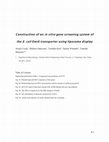
Analytical chemistry, Jan 20, 2016
Liposome display is a method that enables the directed evolution of membrane proteins in vitro. T... more Liposome display is a method that enables the directed evolution of membrane proteins in vitro. The method is based on the syntheses of membrane proteins using an in vitro transcription-translation system (IVTT) inside cell-sized phospholipid vesicles from a single copy of template DNA. So far, a large number of membrane proteins have been synthesized by IVTT; however, none of these proteins, except for α-hemolysin, has been tested for use in gene screening with liposome display. Here, using EmrE, a multidrug transporter from Escherichia coli,, as a model protein, we developed an in vitro screening system of the transporter gene based on its function, which was made possible by using liposome display. The screening was performed based on two functions of EmrE: substrate transport activity and membrane integration activity. Starting from a mock gene library prepared by mixing an active and an inactive gene, 10- to 35-fold enrichment of the active genes was obtained, which was in the ...
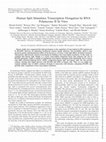
Molecular and Cellular Biology, 2004
Recent studies have suggested that Spt6 participates in the regulation of transcription by RNA po... more Recent studies have suggested that Spt6 participates in the regulation of transcription by RNA polymerase II (RNAPII). However, its underlying mechanism remains largely unknown. One possibility, which is supported by genetic and biochemical studies of Saccharomyces cerevisiae , is that Spt6 affects chromatin structure. Alternatively, Spt6 directly controls transcription by binding to the transcription machinery. In this study, we establish that human Spt6 (hSpt6) is a classic transcription elongation factor that enhances the rate of RNAPII elongation. hSpt6 is capable of stimulating transcription elongation both individually and in concert with DRB sensitivity-inducing factor (DSIF), comprising human Spt5 and human Spt4. We also provide evidence showing that hSpt6 interacts with RNAPII and DSIF in human cells. Thus, in vivo, hSpt6 may regulate multiple steps of mRNA synthesis through its interaction with histones, elongating RNAPII, and possibly other components of the transcription...
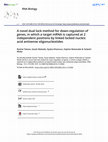
RNA biology, Jan 3, 2016
Nuclear factor κB (NFκB), which is composed of the RelA and p50 subunits, binds to NFκB response ... more Nuclear factor κB (NFκB), which is composed of the RelA and p50 subunits, binds to NFκB response elements (NREs) and stimulates the transcription of inflammation-related genes. Here, locked nucleic acid (LNA) antisense oligonucleotides (ASOs) complementary to the termini of the 3'- and 5'-untranslated regions (UTRs) of the RelA mRNA were generated; these molecules were named 3'-LNA and 5'-LNA, respectively. To evaluate their effects on NFκB activity, HeLa cells were co-transfected with the LNA ASOs and a luciferase reporter gene carrying an NRE. Transfection of the cells with 3'-LNA reduced NFκB activity by 30-40%, without affecting RelA mRNA accumulation. Concomitant transfection of HeLa cells with 5'-LNA and 3'-LNA resulted in a 70% reduction in NFκB activity. Furthermore, partial poly(A) tail shortening occurred in LNA ASO-transfected cells. We also employed triethylene glycol as a spacer to link 5'-LNA and 3'-LNA. Reporter gene assays showed t...
Bioscience, biotechnology, and biochemistry, 2014
Diploid baker's yeast capable of strongly activating a mouse macrophage was constructed based... more Diploid baker's yeast capable of strongly activating a mouse macrophage was constructed based on haploid mutant AQ-37 obtained previously. The obtained strain BQ-55 activated also human immune cells. To clarify a factor for the activation, the cell wall structure, especially the β-glucan structure, was analyzed, suggesting that the length of branching, β-1,6-glucan, may be one of the factors.
The Journal of General and Applied Microbiology, 2011
Baker s yeast Saccharomyces cerevisiae is an essential ingredient in bakery products produced by ... more Baker s yeast Saccharomyces cerevisiae is an essential ingredient in bakery products produced by dough fermentation. The properties of baker s yeast cells in commercial products, such as fermentation ability, stress tolerance, and fl avor formation, depend on both the cultivation conditions and the genetic constitution of yeast strains (Evance, 1990; Nagodawithana and Trivedi, 1990). The breeding methods of bak
Proceedings of the National Academy of Sciences, 1991
Transcription of the fibroin gene can be reconstituted with partially purified components from He... more Transcription of the fibroin gene can be reconstituted with partially purified components from HeLa cells. Transcription factors IIB, IID, and IIE and RNA polymerase II are required for accurate initiation of transcription. Linear and relaxed closed circular DNA show a similar level of template activity. However, transcription of closed circular DNA is stimulated when negative supercoils are introduced by the addition of DNA topoisomerase II and supercoiling factor purified from the posterior silk gland of Bombyx mori. Dissection of transcription into pre- and postinitiation steps by the use of Sarkosyl reveals that DNA supercoiling promotes formation of a preinitiation complex. Furthermore, order of addition experiments suggest that DNA supercoiling facilitates a functional binding of transcription factor IID to the promoter.

Nucleic Acids Research, 1989
R STmple method with the use of affinity latex particles has been developed for the fast and effi... more R STmple method with the use of affinity latex particles has been developed for the fast and efficient purification of sequence-specific DNA-bindlng proteins on the basis of their ability to selectively Bind to their target sequences. Complementary oligodeoxynucleotldes that contained a recognition site for a sequence-specific DNA-binding protein were chemically synthesized, annealed and Heated to give ollgomers. The oligomers were coupled to latex particles, composed of polyglycidyl methacrylate, using cyanogen bromide to yield affinity latex particles. The concentration of covalently bound DNA on the affinity latex particles was 6 times as much DNA per ml as that in the Sepharose resin conventionally used. By sequential batch-wise procedures with the affinity particles, one of the sequence-specific DNA binding transcription factors, ATF or E4TF3, was quickly and efficiently purified to homogeneity from either a protein fraction in which the factor was enriched or a crude cell extract.
Molecular Pharmacology, 2013
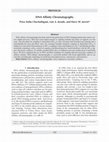
Molecular Biotechnology, 2001
DNA-affinity chromatography has been used for the purification of DNA-binding proteins that contr... more DNA-affinity chromatography has been used for the purification of DNA-binding proteins that control various cellular processes. There have been improvements in coupling methods and choice of supports over the years. The procedure for coupling 5'-aminoethyl-(dT) 18 to silica activated with N-hydroxysuccinimide and a carbodiimide has been described. Also, the cyanogen bromide mediated coupling of aminoethyl-(dT) 18 to Sepharose is described. Determination of (dT) 18-coupling to silica and Sepharose is by 5' end-labeling an oligonucleotide containing a (dA) 18 stretch of sequence and determining how much hybridizes with the (dT) 18 support. Enzymatic synthesis of a double-stranded DNA-silica or Sepharose prevents modification of nucleotide bases. We have explained the use of DNA and RNA templates for template-directed enzymatic synthesis of affinity columns. DNA-affinity chromatography is a powerful method with broad applicability and we are currently extending this technology for purifying transcription factors, polymerases, and nucleases.
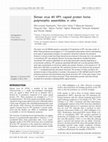
Journal of General Virology, 2003
The simian virus 40 (SV40) capsid is composed of 72 pentamers of VP1, the major protein of SV40. ... more The simian virus 40 (SV40) capsid is composed of 72 pentamers of VP1, the major protein of SV40. These pentamers are arranged in a T=7d icosahedral surface lattice, which is maintained by three types of appropriately arranged, non-equivalent interactions between the pentamers. However, it remains unclear how these interactions are achieved. In this study, the in vitro assembly of recombinant VP1 was analysed. Electron microscopy observations revealed that these recombinant VP1 proteins assembled into structurally polymorphic particles depending on environmental conditions. VP1 pentamers assembled efficiently into virus-like particles (VLPs) when high concentrations of ammonium sulfate were present. However, in the presence of 1 M NaCl and 2 mM CaCl 2 at neutral pH, VP1 pentamers formed not only VLPs but also produced tiny T=1 icosahedral particles and tubular structures. The exclusion of CaCl 2 resulted in the exclusive formation of tiny particles. In contrast, in the presence of 150 mM NaCl at pH 5, the VP1 pentamers produced only extraordinarily long tubular structures. VP1 is thus quite unique in that it can assemble into such diverse structures. These observations provide clues that will help elucidate the mechanisms underlying SV40 capsid formation.
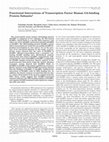
Journal of Biological Chemistry, 1998
The transcription factor human GA-binding protein (hGABP) is composed of two subunits, the Ets-re... more The transcription factor human GA-binding protein (hGABP) is composed of two subunits, the Ets-related hGABP␣, which binds to a specific DNA sequence, and either one of two hGABP␣-associated subunits, hGABP or hGABP␥. The DNA-binding protein hGABP␣ cannot affect transcription by itself, but can modify hGABP-dependent transcription in vitro and in vivo in the presence of its associated subunits. In this study, co-transfection assays showed that the ratio of hGABP to hGABP␥ affected transcription from a promoter containing hGABP binding sites. Biochemical analysis showed that they bind to hGABP␣ competitively, indicating that the ratio of hGABP to hGABP␥ is important for hGABP complex formation. Kinetic analysis of the protein-protein interaction using the surface plasmon resonance system showed that hGABP␣ binds to hGABP or hGABP␥ with similar equilibrium constants. Kinetic analysis of the DNA-hGABP interaction showed that the binding of hGABP␥ to hGABP␣ stabilized the interaction of hGABP␣ with its DNA binding site. In addition, the kinetic analysis revealed that this was due to a slower dissociation of the protein complex from the DNA. These results suggest that hGABP␣-associated subunits influence the DNA binding stability of hGABP␣ and regulate hGABP-mediated transcription by competing with each other.

Journal of Biological Chemistry, 2002
Reduction-oxidation (redox) regulation has been implicated in the activation of the transcription... more Reduction-oxidation (redox) regulation has been implicated in the activation of the transcription factor NF-B. However, the significance and mechanism of the redox regulation remain elusive, mainly due to the technical limitations caused by rapid proton transfer in redox reactions and by the presence of many redox molecules within cells. Here we establish versatile methods for measuring redox states of proteins and their individual cysteine residues in vitro and in vivo, involving thiolmodifying reagents and LC-MS analysis. Using these methods, we demonstrate that the redox state of NF-B is spatially regulated by its subcellular localization. While the p65 subunit and most cysteine residues of the p50 subunit are reduced similarly in the cytoplasm and in the nucleus, Cys-62 of p50 is highly oxidized in the cytoplasm and strongly reduced in the nucleus. The reduced form of Cys-62 is essential for the DNA binding activity of NF-B. Several lines of evidence suggest that the redox factor Ref-1 is involved in Cys-62 reduction in the nucleus. We propose that the Ref-1-dependent reduction of p50 in the nucleus is a necessary step for NF-B activation. This study also provides the first example of a drug that inhibits the redox reaction between two specific proteins.
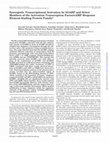
Journal of Biological Chemistry, 1999
The Ets-related DNA-binding protein human GA-binding protein (hGABP) ␣ interacts with the four an... more The Ets-related DNA-binding protein human GA-binding protein (hGABP) ␣ interacts with the four ankyrintype repeats of hGABP to form an hGABP tetrameric complex that stimulates transcription through the adenovirus early 4 (E4) promoter. Using co-transfection assays, this study demonstrated that the hGABP complex mediated efficient activation of transcription from E4 promoter synergistically with activating transcription factor (ATF) 1 or cAMP response element-binding protein (CREB), but not ATF2/CRE-BP1. This synergy also partially occurred when hGABP␣ was used alone in place of the combination of hGABP␣ and hGABP. hGABP activated an artificial promoter containing only ATF/CREB-binding sites under coexistence of ATF1 or CREB. Consistent with these results, physical interactions of hGABP␣ with ATF1 or CREB were observed in vitro. Functional domain analyses of the physical interactions revealed that the amino-terminal region of hGABP␣ bound to the DNA-binding domain of ATF1, which resulted in the formation of ternary complexes composed of ATF1, hGABP␣, and hGABP. In contrast to hGABP␣, hGABP did not significantly interact with ATF1 and CREB. Taken together, these results indicate that hGABP functionally interacts with selective members of the ATF/CREB family, and also suggest that synergy results from multiple interactions which mediate stabilization of large complexes within the regulatory elements of the promoter region, including DNA-binding and non-DNA-binding factors.











Uploads
Papers by Hajime Watanabe